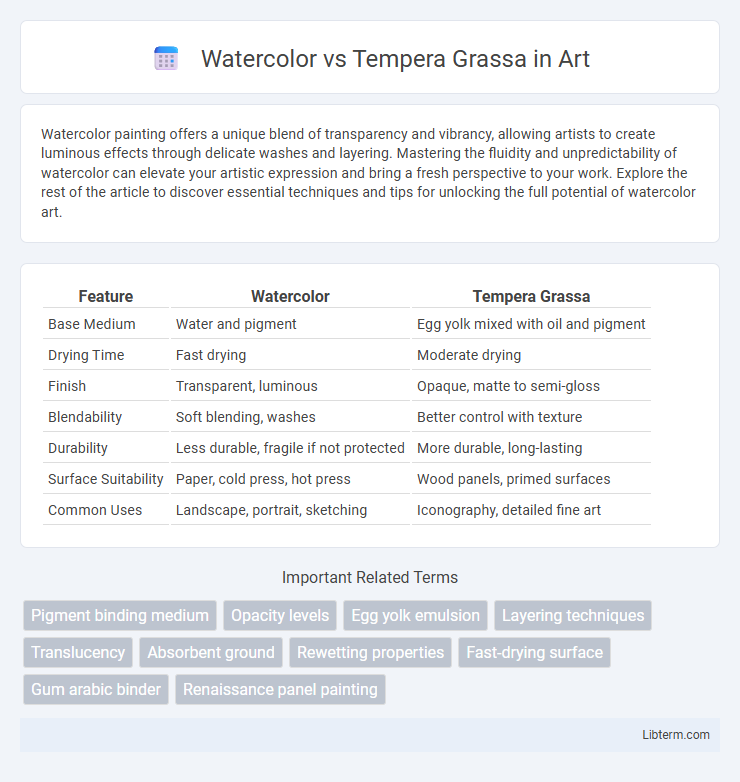Watercolor painting offers a unique blend of transparency and vibrancy, allowing artists to create luminous effects through delicate washes and layering. Mastering the fluidity and unpredictability of watercolor can elevate your artistic expression and bring a fresh perspective to your work. Explore the rest of the article to discover essential techniques and tips for unlocking the full potential of watercolor art.
Table of Comparison
| Feature | Watercolor | Tempera Grassa |
|---|---|---|
| Base Medium | Water and pigment | Egg yolk mixed with oil and pigment |
| Drying Time | Fast drying | Moderate drying |
| Finish | Transparent, luminous | Opaque, matte to semi-gloss |
| Blendability | Soft blending, washes | Better control with texture |
| Durability | Less durable, fragile if not protected | More durable, long-lasting |
| Surface Suitability | Paper, cold press, hot press | Wood panels, primed surfaces |
| Common Uses | Landscape, portrait, sketching | Iconography, detailed fine art |
Introduction to Watercolor and Tempera Grassa
Watercolor is a translucent paint medium composed of pigments suspended in a water-soluble binder, allowing for light washes and subtle gradients ideal for delicate and transparent artwork. Tempera Grassa, a traditional oil-based medium mixed with water and egg yolk or oils, offers a rich, matte finish with greater opacity and faster drying time than typical oil paints. Both mediums require distinct techniques: watercolor excels in fluid layering and luminosity, while Tempera Grassa provides vibrant colors with durability and slight flexibility.
Historical Background of Both Mediums
Watercolor painting dates back to ancient Egypt and was extensively used in medieval manuscripts and botanical illustrations due to its translucent properties and ease of application on paper. Tempera grassa, an oil-modified egg tempera, evolved during the Renaissance as artists sought more flexibility and durability in their paintings, combining traditional egg tempera with oil to create richer textures and extended drying times. The historical development of watercolor emphasizes portability and clarity, while tempera grassa reflects a transitional medium bridging egg tempera and oil painting techniques.
Composition and Ingredients
Watercolor paint is primarily composed of finely ground pigments suspended in a water-soluble binder, usually gum arabic, resulting in transparent and fluid application. Tempera grassa, a variation of traditional tempera, uses pigments mixed with a combination of water and a fat-based medium such as egg yolk or oil, creating a rich, opaque texture with quick drying properties. The differing binders and fat content significantly affect the paint's durability, blending capabilities, and finish, with watercolor favoring luminosity and tempera grassa offering vibrant, matte coverage.
Techniques and Application
Watercolor utilizes transparent pigments diluted with water, allowing for smooth layering, subtle gradients, and light washes that enhance luminosity and softness in paintings. Tempera Grassa, a mixture of egg yolk and oil, offers a thicker, more opaque consistency enabling richer textures, faster drying times, and more controlled brushwork suitable for fine detail and robust color application. Techniques in watercolor emphasize blending and fluidity, while tempera grassa requires deliberate layering and precision to achieve depth and vibrancy.
Drying Time and Layering
Watercolor dries quickly, often within minutes, making it ideal for rapid layering but requiring careful timing to prevent colors from blending unintentionally. Tempera grassa has a slower drying time due to its oil content, allowing more working time and smoother blending between layers. The extended drying period of tempera grassa supports building rich, opaque layers, while watercolor achieves transparency and lightness with thinner, faster-drying washes.
Color Vibrancy and Longevity
Watercolor paints offer a transparent, luminous quality with colors that can fade over time when exposed to light, making them ideal for delicate, light-infused artwork but requiring careful preservation. Tempera grassa, a medium combining egg tempera with oil, produces rich, opaque colors with superior vibrancy and excellent longevity, resistant to yellowing and cracking. Artists seeking durable, intense hues often prefer tempera grassa for works intended to last centuries without significant color degradation.
Surface Compatibility
Watercolor exhibits excellent surface compatibility with absorbent papers such as cold-pressed or rough-textured watercolor paper, where its translucency enhances texture and layering effects. Tempera Grassa, an oil-based medium modified with water-soluble components, adheres effectively to primed surfaces including gessoed boards and canvas, maintaining vibrancy and durability without cracking. Choice of medium significantly influences texture and longevity, with watercolor favoring porous substrates and Tempera Grassa thriving on sealed, prepared surfaces.
Artistic Styles and Effects
Watercolor produces translucent, layered washes that emphasize lightness and fluidity, ideal for delicate, atmospheric effects in landscapes and portraits. Tempera grassa, blending egg yolk and oil, offers a richer, more opaque finish with vibrant color saturation and durability, suited for detailed, textural work in Renaissance or classical styles. The choice between these mediums influences artistic expression, color depth, and surface texture, shaping the overall visual impact of the artwork.
Pros and Cons Comparison
Watercolor offers transparent washes that create luminous effects ideal for delicate blending, but it can be challenging to control and less forgiving of mistakes. Tempera grassa provides richer, more opaque colors with a creamy texture allowing for easier layering and correction, yet it requires longer drying times and can be heavier on the paper surface. Watercolor suits quick, fluid painting styles, while tempera grassa supports detailed work with vibrant, matte finishes.
Choosing the Right Medium for Your Art
Watercolor offers transparency and fluidity ideal for delicate washes and detailed layering, making it perfect for artists seeking luminous effects and subtle gradients. Tempera grassa, a fat-based egg tempera variant, provides rich, opaque colors with a creamy texture, suited for those who prefer vibrant hues and a more tactile painting experience. Selecting the right medium depends on your desired aesthetic, drying time preference, and the painting's longevity requirements, ensuring your artistic vision aligns with the medium's unique properties.
Watercolor Infographic

 libterm.com
libterm.com